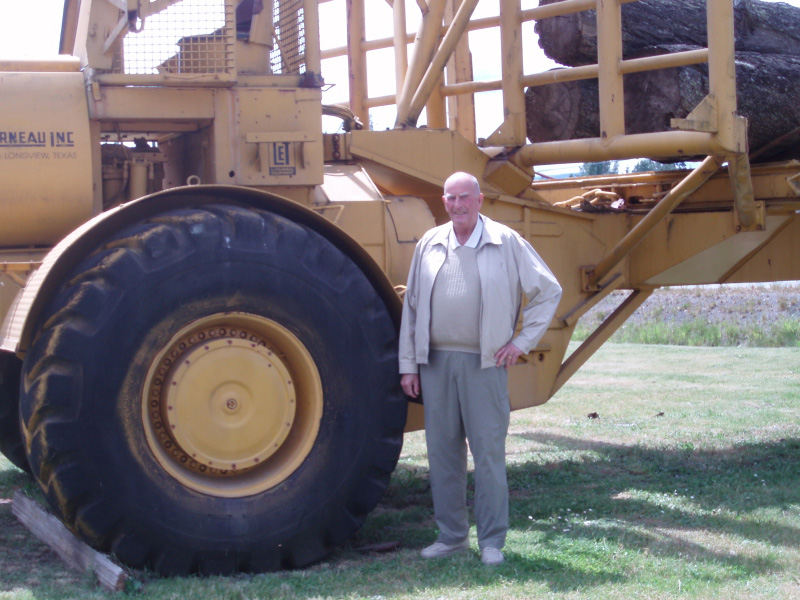
Photo Courtesy BC Forest Discovery Centre. Photo taken in May 2007 of Bruce Russell standing beside the 1958 LeTourneau Log Transporter, series T that he operated for Crabapple Creek Logging when it was new.
Young loggers moved through various camps in BC and worked in many different positions from whistle punks to equipment operators. Although their goal was simply to earn a living, these workers were involved in places and new technology that became important to the heritage of the forest industry. Bruce Russell’s experiences as a young logger were typical and his connection to the past provides a glimpse into the forest industry 50 years ago.
Bruce Russell arrived at the Copper Canyon camp, 20 miles west of Chemainus, in 1951 with seven other men. Copper Canyon supplied timber for the Chemainus sawmill and was owned by forest giant MacMillan Bloedel. All eight of the newcomers shared a bunkhouse and got up at 6:00 am for the early shift and commuted 90 minutes by speeder on the railway to start work at the logging operation by 8:00.
Russell started out as one of eight men on the bull gang setting up the rigging. The bull gang raised the wooden spar tree and set up the guylines or cables to transport logs from the spot they were felled to the loading area for the train. At the end of the day there was so much food served in the cookhouse that Russell thought he had died and gone to heaven, an experience he remembered for decades. Russell’s job at Copper Canyon came to an abrupt end just two weeks after it began when three of his rowdy bunkmates wrecked the bunkhouse, resulting in the dismissal of all eight men.
Undeterred by his experience in Copper Canyon, Russell stayed in the forest industry and later worked for Crabapple Creek Logging on the Sunshine Coast in 1957. Crabapple Creek Logging purchased a LeTourneau Log Transporter T, the first one of these cutting-edge off-road trucks to appear on the coast. The Log Transporter had six independently driven wheels, each powered by an electric motor that controlled the speed, direction and braking of the truck. A remote control replaced the steering wheel, brakes, and throttle and LeTourneau paid for Russell’s operator training.
The Log Transporter was unmatched by other trucks for its ability to handle rough roads, even by logging standards. The truck was able to run on roads that didn’t have drainage, gravel or grading. In order to get better visibility when driving in reverse, Bruce sat on a seat attached to the outside of the truck and used the remote control to back the truck down switchbacks.
Bunkhouses like the one Russell’s bunkmates destroyed are preserved and on display at the BC Forest Discovery Centre to show new generations and visitors what it was like to live in a logging camp. The same LeTourneau Log Transporter that Russell backed down switchbacks while perched precariously on the outside of the truck travelled to the BC Forest Discovery Centre in 1994 and is now on display. Regular people like Bruce Russell became a part of logging history and are an important connection to our past.


